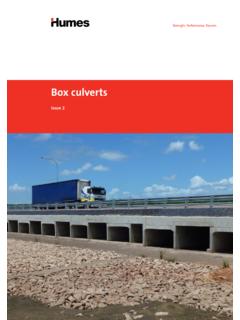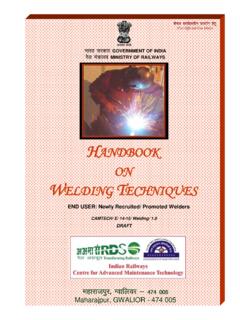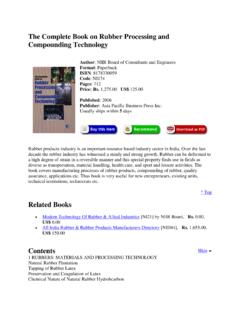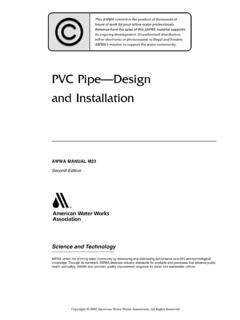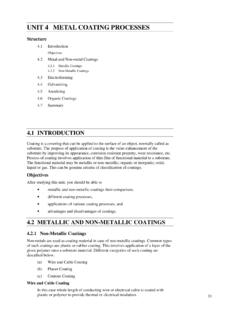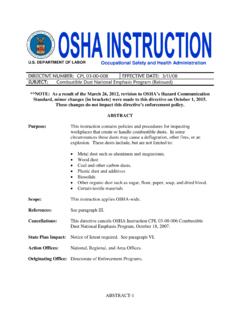Transcription of Concrete pipe reference manual - Holcim
1 Concrete pipe reference manualIssue 1 Strength. Performance. Introduction3 Manufacturing3 Joint types3 Durability4 Hydraulics4 Size class (DN)4 Load class52. Test load data 103. Pipes for culvert applications 11 Flush Joint (FJ) pipes11 rubber Ring Joint (RRJ) pipes11 Load class13 Hydraulics13 Inlet control14 Outlet control14 Installation15 Other culvert products164. Pipes for drainage applications17 rubber Ring Joint (belled socket) pipes17 rubber Ring Joint (in-wall) pipes20 Hydraulics21 Load class21 Installation22 Other stormwater products225. Pipes for sewerage applications23 Corrosion protection options23 rubber Ring Joint (RRJ) pipes24 Size class (DN)24 Load class24 Hydraulics24 Installation24 Other sewerage products256.
2 Pipes for pressure applications27 rubber Ring Joint (RRJ) pipes27 Size class (DN)29 Load/pressure class29 Hydraulics32 Other pressure pipe products34 Field hydrostatic testing357. Pipes for irrigation applications36 rubber Ring Joint (RRJ) pipes36 Size class (DN)37 Load/pressure class37 Hydraulics388. Jacking pipes39 Butt joint jacking pipes39S series jacking pipes40J series jacking pipes40 selection guide41 Size class (DN)42 Load class42 Hydraulics42 Installation439. Handling and installation44 Placing your order44 Arriving on site44 Handling on site45 Digging trenches46 Preparing the foundation46 Placing bedding47 Laying pipes48 Jointing pipes49 Bedding and backfilling5110. reference material55 ContentsPlease note:The information in this publication does not apply to pipes manufactured at our Thornton NSW or Ipswich QLD factories.
3 For specific information on pipes manufactured at these two locations please speak to your Humes representative.* Concrete pipe reference manual 31. Introduction1. IntroductionThis publication provides the information necessary to specify Humes Concrete pipes for all of these steel reinforced Concrete pipes are made from coarse and fine aggregates, cement and hard drawn deformed steel reinforcement. They are manufactured and factory tested for quality to AS/NZS 4058: Precast Concrete Pipes (Pressure and Non-Pressure). Pipes can also be custom made and tested to meet specific customer abrasion resistance and the impermeability of Concrete makes SRCP the most appropriate selection for handling peak flows.
4 A range of natural characteristics further enhance performance, including an indefinite increase in strength in the presence of moisture and autogenous healing of is the leading manufacturer of Steel Reinforced Concrete Pipes (SRCP) and associated precast products in Australia. Available in a wide range of diameters, lengths and with varying strengths. Humes Concrete pipes have a proven track record and are custom designed for user applications including drainage, sewerage, water supply and typesHumes Concrete pipes are manufactured with two basic joint types - Flush Joint (FJ) and rubber Ring Joint (RRJ).FJ pipes provide an interlocking joint which allows for a small degree of flexibility in the pipeline alignment.
5 RRJ pipes, either belled-socket or in-wall joint depending on the diameter of the pipe and its application, are designed to accommodate change in pipeline alignment and settlement in a pipeline whilst still maintaining a watertight information on the joints specific to the pipe application types are provided in the relevant sections of this manual . Concrete pipe reference manual 41. IntroductionDurabilityFor most common installations, the service life of Concrete pipes is virtually unlimited. The longevity of steel reinforced Concrete pipe provides asset managers with a resource requiring low in-service maintenance and the ability to be recycled into other projects if exhumed. Some of the Roman aqueducts are still in use after 2,000 years and samples from the first known Concrete pipes in the US, laid in 1842, were in excellent condition after more than 140 years the 350 million kilometres plus of reinforced Concrete pipe that has been laid in Australia, the number of pipelines which have suffered from durability problems has been extremely small and confined mainly to unprotected pipe in highly aggressive conditions.
6 Advances in Concrete , process and product technologies such as the use of HDPE linings for sewer pipelines together with our stringent quality control and assurance programs ensures that our pipes and associated products will be fit for their establish the flow rates for the various types of Concrete pipes the Manning's formula should be used for short run culvert and drainage applications, while the Colebrook-White formula should be used for long run drainage, gravity sewer lines and all pressure pipe Concrete Pipe Association of Australasia (CPAA) publication "Hydraulics of Precast Concrete Conduits" is recommended as a reference . Comprehensive details on the hydraulics for the different pipe types are provided in each class (DN)Humes standard range of Concrete pipes are available in sizes DN300 - DN2100 (DN = nominal diameter).
7 Diameters outside the standard range and up to DN3600 are also available. Special project pipes are also available for all sizes when required or Concrete pipes are typically manufactured in nominal m lengths to optimise transport and handling. Other lengths, longer or shorter can be manufactured on request. Comprehensive tables listing the availability of size classes (DN) are provided in each section. Concrete pipe reference manual 51. IntroductionLoad classHumes steel reinforced Concrete pipes are available in standard-strength (class 2-4) and super-strength (class 6-10) load numeric classification system adopted to identify the load carrying capacity of Concrete pipes is based on the rationale that any particular pipe class is able to carry approximately the same proportionate height of fill.
8 For example, a class 10 pipe can carry five times the height of fill of a class 2 pipe, under the same installation conditions. See Section 2 Test load data, for further information on test loads for each size required strength of a Concrete pipe depends on both the load to be carried by the installed pipe, and the supporting ground installation conditions. The load transmitted onto the pipe depends on the height and the type of fill material. Also, when installed in a trench, the width of the trench at the top of the pipe is important. Generally the wider the trench, the greater the load for any height of fill over the load class for Concrete pipes can be determined by consulting AS/NZS 3725: Design for Installation of Buried Concrete Pipes which provides methods for determining the installed load on Concrete pipes from the earth fill over the pipes as well as any induced live (vehicle) load standard also provides a range of recommended bedding support type options.
9 The range varies from no support, to haunch support, to haunch and side the majority of pipe installations, Humes standard-strength (class 2-4) Concrete pipes, used in conjunction with type H2 or type HS2 bedding support, are suitable (see Figure on the following page).The letter H in the terminology indicates Haunch support only. HS indicates both Haunch and Side support. The numerals after H and HS indicate the level of support in the material used. Tables (page 6) and (page 7) for bedding type H2 and HS2 are provided for ease of specifying Concrete pipes within a limited range of stated conditions. Figure below compares the results for a sample pipe installation using both type H and type HS bedding supports.
10 Similarly, for embankment installation, Table (page 9) is Indicative depth of fill for various bedding installation typesNote:It may be more economical to modify bedding type than to increase pipe surfaceIndicative depth of fillH2 BeddingHS2 BeddingHS3 Bedding Concrete pipe reference manual 61. IntroductionTable Material quantities - H1 and HS1 support typesSize class(DN) Min trench width (m)Material quantities (m3 )Bedding zoneHaunch zoneH1 Overlay zoneHS1 side zoneHS1 Overlay , , , , , ,0501, ,2001, ,3502, ,5002, ,6502, ,8002, ,9502, ,1003, : Volume quantities are approximate and based on an assumed 10% Type H1 and type H2 supports150 mm min. overlayHaunchHaunchBedBedFinished surfaceNatural ground surface or compacted filllc D/6 or 150 mm, whichever is greater*lc D/6 or 150 mm, whichever is greater** Refer AS/NZS 3725 for cement stabilised soilCompactedCompactedCompactedCompacted D/3D/3 EmbankmentTrenchCompacted select fill150 mm ordinary fill150 mm min.

